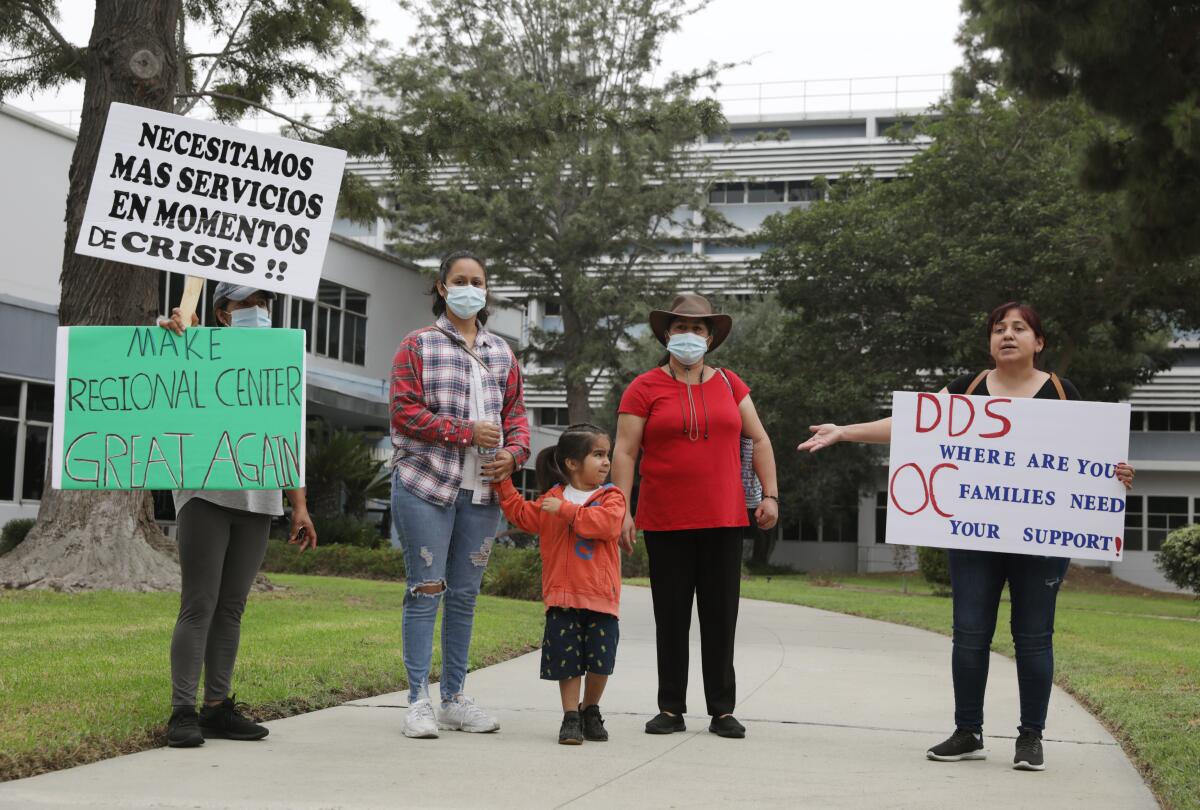In California, spending on adults with disabilities differs by ‘race and place’

The system charged with ensuring that California adults with developmental disabilities get crucial services is plagued with stark differences in spending by race, ethnicity and where people live, according to a report released Wednesday by a disability advocacy group.
The report from Disability Voices United, titled “A Matter of Race and Place,” builds on long-standing concerns about racial disparities at regional centers — a system of nonprofits that are responsible for coordinating services for developmentally disabled children and adults. It also underscores dramatic differences in spending between centers serving different parts of California.
“We shouldn’t have 21 different ways that people are receiving services,” said Judy Mark, president of Disability Voices United, who is also the parent of an adult served by a regional center. “It shouldn’t be based on where you live or what your race or ethnicity is.”
Regional centers provide assistance under contracts with the California Department of Developmental Services, which has invested tens of millions of dollars in recent years to try to close racial and ethnic gaps in spending. Earlier this year, the legal advocacy group Public Counsel found racial disparities had nonetheless persisted in spending on services for children and teens.
The report released Wednesday found similar kinds of problems with spending on adults with developmental disabilities. And at the majority of regional centers, disparities in spending between Latino and white adults had worsened over time, the report concluded.
The Department of Developmental Services said it welcomed the report and “has made it a priority to approach these discrepancies in a thoughtful and systematic way.”
“Although important progress has been made in recent years, there still is much room for improvement,” the department said in a statement.
Amy Westling, executive director of the Assn. of Regional Center Agencies, said a number of factors drive spending levels at the centers, including whether they are supporting lots of people with more costly needs who used to live in state-operated centers, different caps on rates that centers pay for services and challenges finding easy-to-access services in areas without big cities.
Racial and ethnic gaps in spending on services for California children and teens with developmental disabilities persist, a new report has found.
Some regional centers have argued that spending gaps are the result of cultural differences in whether adults live at home with their families, rather than in more expensive facilities, the report said. But among adults living at home, Disability Voices United still found disparities in how much regional centers were spending on clients of different races and ethnicities.
Lanterman Regional Center, which serves an area that includes central L.A., Hollywood, Glendale and Pasadena, had the state’s biggest gap by dollars — $8,561 in fiscal year 2020-2021 — in average spending per person on adults of different racial and ethnic groups who were living at home, with Latinos getting the least, the report found.
Lanterman Executive Director Melinda Sullivan said in a statement that the regional center understands there are concerns surrounding disparities and was taking time to carefully review the report. The center “will continue our efforts to improve upon equities in the levels of services provided to all Lanterman families and individuals served regardless of race or ethnicity,” she said.
In Southern California, racial disparities in dollars spent on adults living at home were also especially apparent at the North Los Angeles and Orange County regional centers, the report found. At a news conference, Claudia Rivera said that the Regional Center of Orange County had repeatedly turned her down to obtain many services for her two sons with disabilities.
Her 29-year-old son has repeatedly gotten lost for days or even weeks, Rivera said, and the only assistance the regional center has provided their family is 30 hours per month of respite care — someone to temporarily watch her son at home.
“It’s been really hard for me. I’ve even wanted to die when he gets lost because I don’t know what to do,” Rivera told reporters through an interpreter, speaking in Spanish.
Larry Landauer, executive director of the Regional Center of Orange County, said he could not comment on any individual client, but that what the Orange County parent had described was “not acceptable.” Landauer said his center had been studying disparities and pursued “intensive case management” for Latino clients who had gotten little or no services.
“We’ve always been trained, under [state law], to say, ‘What is the need of this individual?’” he said.
Disability rights activist Alice Wong’s debut memoir is out Tuesday. But don’t expect to see her on a book tour, read from her work or sign copies.
Mark faulted a “culture of no” at regional centers that is easier to fight for those with more resources, including white families and English speakers. Fernando Gomez, a parent and co-founder of Integrated Community Collaborative, said “the system is just so hard to navigate.”
Westling, whose association represents regional centers across California, said the group’s analysis had found that overall regional center spending on Latino and Asian people living with their families was “only slightly below parity” compared with white adults, and that spending on white and Black adults living with their families was similar. Mark said their new analysis differed by examining individual centers, rather than statewide figures.
The report also found that “where you live matters as much as your race.” Some centers have been spending much more per person than others, Disability Voices United found. Among them was Westside Regional Center, which serves western and coastal parts of Los Angeles County.
Westside Regional Center was spending an average of more than $30,000 each on adult clients living at home — nearly three times as much as San Diego Regional Center, which was spending an average of less than $11,000 on each adult living at home, the report found.
Mark pointed out that Latino adults living at home and served by Westside did not get as much on average as their white counterparts, but they were receiving more services than “almost every other adult living at home — regardless of race” at other regional centers.
Disability Voices United also found “enormous differences” in what regional centers were spending to support adults who were living away from their families in their own places. Eastern Los Angeles Regional Center was spending an average of more than $80,000 for each of those clients, compared with roughly $14,000 per client at Inland Regional Center, which serves clients in Riverside and San Bernardino counties, the report found. And the report also found big differences from center to center in spending on adults in residential settings.
Disability Voices United argued that to address the inequities, California lawmakers and the Department of Developmental Services need to step up oversight and accountability for regional centers with big disparities, including reassessing the individual plans for clients at inequitable centers to see if more services should be approved.
It also called for state lawmakers to demand accountability for the money spent to address inequities and target the state grants to geographic areas and groups worst affected by disparities.
The Department of Developmental Services said it had enlisted Georgetown University to evaluate its grant program to ensure the money was going to effective efforts, among other steps to address disparities. The department added that although costs of services differ from region to region, it was seeking to minimize those differences through a new program that would add $2.1 billion to support services by 2024-25.
More to Read
Sign up for Essential California
The most important California stories and recommendations in your inbox every morning.
You may occasionally receive promotional content from the Los Angeles Times.













